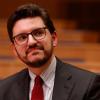Sunday's prayer service at the Vatican for peace in the Middle East, hosted by Pope Francis and attended by both the Israeli and Palestinian presidents, will involve prayers in the traditions of all three Abrahamic faiths and a symbolic planting of an olive tree, the Vatican announced Friday.
Besides Israel's Shimon Peres and Palestine's Mahmoud Abbas, the summit will also be attended by Ecumenical Patriarch Bartholomew, considered "first among equals" in Eastern Orthodox Christianity.
The summit, the fruit of an invitation the pontiff made to the Middle East leaders during his three-day visit to the Holy Land at the end of May, is being seen as a potential landmark point in what has become a stalled peace process between the two states.
The rundown of the event -- which was released following a press briefing at the Vatican from spokesman Jesuit Fr. Federico Lombardi and Franciscan Fr. Pierbattista Pizzaballa, who serves as the head of the main Franciscan order in the Holy Land and cares for the order's extensive property holdings in the region -- paints a picture of a possibly highly symbolic evening.
Following their separate arrival at the Vatican around 6:30 PM in Rome Sunday night, Peres and Abbas are to join Francis and Bartholomew at the Vatican Gardens, where the summit will take place. At about 7 PM, there are to be prayers from each of the three religions, in chronological order: Judaism, Christianity, and Islam.
The Jewish prayers will be said in Hebrew and will include a prayer praising creation, a prayer invoking forgiveness, a prayer invoking peace, and a musical meditation. The Christian and Muslim prayers will follow the same format. The Christian prayers will be said in English, Italian, and Arabic; the Muslim prayers in Arabic.
The final part of the celebration will include a short discourse from Francis invoking peace; followed by similar discourses from Peres and Abbas. Afterwards, the four leaders will all shake hands and then plant together an olive tree, long held as a symbol of peace and wisdom.
The four will then proceed to a small courtyard and building near the Gardens -- the Casina Pio IV, headquarters of the Pontifical Academy of the Science -- to speak in private.
[Joshua J. McElwee is NCR national correspondent. His email address is jmcelwee@ncronline.org. Follow him on Twitter: @joshjmac.]




